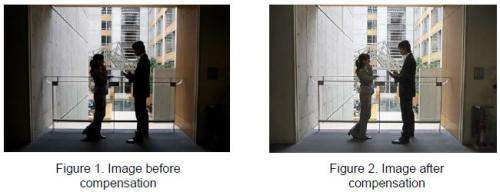Development of visibility enhancement for projector display in bright rooms

Hitachi today announced the development of video processing technology enhancing the visibility of high resolution at a rate of 60 frames per second. Enhanced visibility video display was achieved by analyzing the visual characteristics of the video signals to be displayed, extracting key components contributing to visibility, and enhancing those components. As a result, good visibility of projector displayed video can be achieved without increasing the brightness of the projector light source. To enable this technology to be embedded into various products, the processing algorithm for the hardware structure was optimized, achieving real-time processing of high-resolution video in compact hardware. The technology was first developed for the projector but as it can also enhance visibility in surveillance monitors and vehicular displays, it is expected to find a wide range of application.
With projectors, video images are converted to light and then projected onto a screen. If the screen is too bright due to strong ambient light, the clarity of the projected image deteriorates and so conventionally, a room is dimmed. In recent years however projectors are increasingly being used in brighter environments due to improvements in projector light source and in combination with mobile terminals such as smart phones and tablets.
In order to support such needs, Hitachi has developed video processing technology to enable increased visibility of video images under various ambient levels of brightness. Hitachi Maxell, Ltd., responsible for developing, producing and marketing Hitachi's projectors, has incorporated this technology in the development of an ultimate short throw projector with enhanced visibility, and will be releasing the product in the US and Europe first, followed by other regions.
Conventional processing to enhance visibility includes contrast compensation and color management. These methods however process the entire image displayed as a whole, resulting in an undesirable "side-effect" of reducing visibility in local portions of the image which did not require compensation in the first place, making it difficult to achieve a significant overall improvement through compensation. The technology developed analyzes local characteristics such as brightness and resolution in an image, and compensates by adjusting the characteristics in each locality to reduce the "side-effects" and provide significantly enhanced visibility. Features of the technology are as follows:
Visibility enhancement algorithm based on Retinex theory
A new video compensation algorithm was developed based on the Retinex Theory which models human vision. In this algorithm, several optical components which affect visibility are separated, and depending on characteristics of the video such as brightness, resolution, and color composition, the optical components are enhanced. As a result, the following features were achieved:
(a) Texture: The perception of "sharpness," "gloss" and "shade" were enhanced to improve the clarity of the outline of objects within the video
(b) Contrast: The visibility of the dark regions within a video image were enhanced without influencing the bright regions
(c) Color rendering property: The images were reproduced with vivid coloring without losing any of the original color information
Real-time processing of high resolution video and compact size
In general, as video compensation based on the Retinex Theory requires a large amount of calculation to separate the optical components, the size of the logic circuit and processing time were issues. In order to enable the algorithm developed to be embedded in a product, the processing sequence and tasks which separate, enhance and synthesize the optical components in the video image were optimized to increase the efficiency of the logic circuits inside the hardware; achieving compact logic circuits capable of real-time processing (60 frames/second) of not only still images but also high resolution video (1920 x 1200 pixels). By applying this technology, it will become possible to achieve enhanced visibility high resolution video displays not only in business applications such as in presentations but also in home theatre and amusement applications which require video display, such as movies and broadcasted contents.
Further, as the above processing can be achieved with compact hardware (17x17mm), it can be easily be mounted on small electronic boards such as those for compact projectors and a wide range of applications is expected.
Hitachi Maxell, which develops, produces and markets Hitachi's projectors has developed an ultimate short throw projector embedding this technology, and intend to market this in the US and European, followed by other regions. Hitachi plans to provide the technology as part of visibility enhanced video display solutions for applications such as in-vehicle and surveillance monitors.
Provided by Hitachi




















